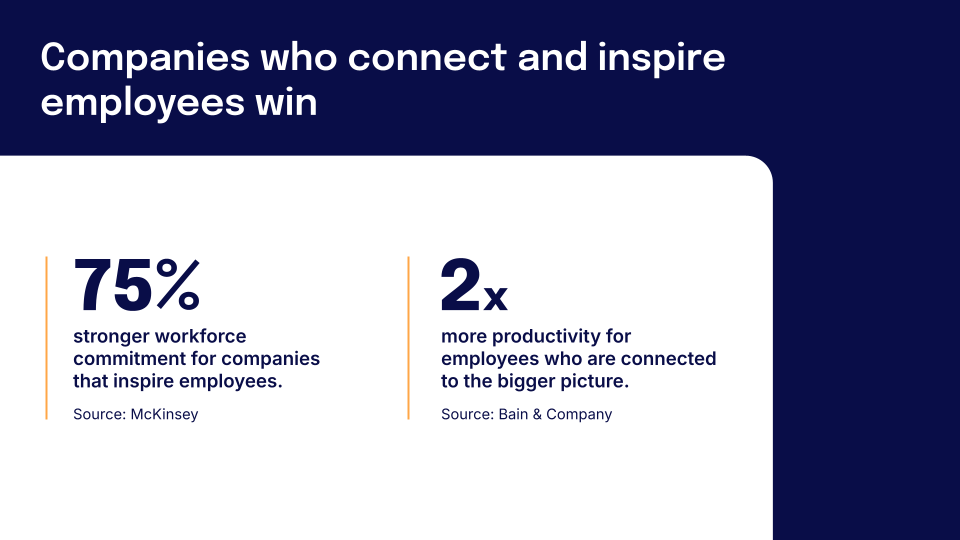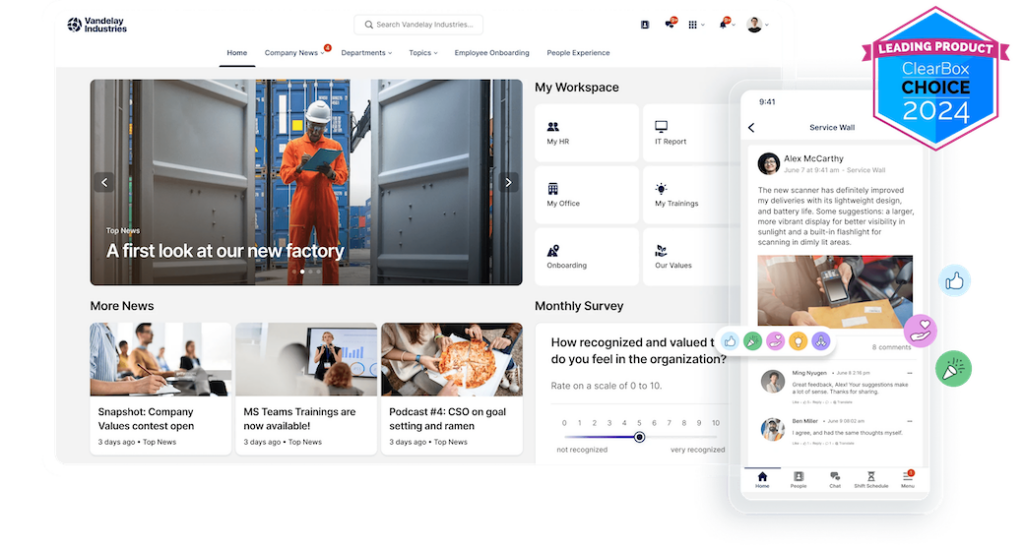As we make our way through 2025, companies are re-evaluating their internal communication strategies — and intranet software plays a pivotal role. In this guide, we compare the best intranet platforms available in 2025, helping you choose the right fit based on your organization’s size, structure, and goals.
What is Intranet Software?
Introduction to Intranets
If you’re on this page, you likely already have a good sense of what an intranet is. It serves as the central hub where your organization’s internal communications and resources come together. A well-designed intranet supports business processes, encourages culture-building, and acts as a critical resource for employees, providing everything from company news to HR forms, project management tools, and more. However, the real challenge is wading through the staggering number of intranet software options available. To make an informed choice, you need to understand your organization’s unique needs and how the right intranet can address them.
Explore more on intranets here. Download the 2023 Gartner® Magic Quadrant™ Report.
How a good intranet software drives business outcomes
Inspired employees achieve more. In our distributed world, connection is more important than ever. A well-implemented intranet can drive business outcomes by helping you create and manage content effectively, provide personalized experiences, and reach employees wherever they are. This not only improves communication but also supports other departments like IT and HR, providing a platform to coordinate announcements, host critical documents, and centralize resources. Dashboards and flexible analytics allow you to track engagement and make data-driven decisions, ensuring your intranet remains a valuable asset.

The top 20 best intranet software solutions
In this section, we compare 20 leading intranet platforms, providing you with the information you need to make an informed choice. For each competitor, we cover their key features, pros and cons, pricing information, and links to G2, Capterra, and Gartner Peer Insights reviews.
1. Staffbase

Tagline: The #1 intranet for communications and engagement
Why You Might Choose Staffbase: Staffbase is purpose-built for strategic, multichannel communications. It helps companies connect employees across every role — from corporate to the frontline—through a unified platform that centralizes content, channels, and insights.
Description: Staffbase began in 2014 with the world’s first Employee App and has since evolved into a full-featured internal communications platform, trusted by more than 2500 organizations worldwide. Its modern intranet combines desktop and mobile access, built-in content governance, and seamless channel integration, making it a top choice for companies with complex communication needs and distributed teams.
Staffbase enables communicators to plan, create, distribute, and analyze content across all employee touchpoints — without relying on IT. Its intuitive user experience, scalability, and native integrations make it ideal for enterprises looking to modernize internal comms.
Key Features
- Companion: A mobile-first app experience tailored to frontline workers. Reach every employee with relevant updates, forms, and access to core systems.
- Smart Impact: Real-time analytics and surveys that measure how your narrative is perceived—not just read.
- Integrations: Connects seamlessly with Microsoft 365, SharePoint, SAP, Workday, and over 70 enterprise tools to unify workflows and content.
- Editorial Calendar & Campaigns: Plan and manage cross-channel communication with full transparency and editorial governance.
- Spaces & Permissions: Organize content by teams, regions, or roles while keeping control centralized.
- Multichannel Publishing: Share updates through intranet, email, digital signage, and SMS—all from one place.
Pros
- Built specifically for internal communication teams, not adapted from legacy IT portals
- Strong support for frontline and mobile employees
- Deep analytics and actionable insights via Smart Impact
- Granular targeting and personalization capabilities
- Scalable to enterprise needs with strong governance and multilingual support
- Excellent onboarding and customer success teams
Cons
- Limited low-level customization (e.g., for developers)
- Strongest presence in North America and Europe; fewer customers in LATAM/APAC
- Not industry-specific, though highly adaptable with Spaces and integrations
Pricing: Available upon request; depends on selected modules and user count.
Ratings
- G2: 4.7 stars (223 reviews)
- Capterra: 4.7 stars (78 reviews)
- Gartner Peer Insights: 4.5 stars (68 ratings)
Trusted by analysts

Staffbase is a Leader in the 2024 Gartner Magic Quadrant for intranet packaged solutions and consistently earns high marks from ClearBox and Forrester for usability, scalability, and customer satisfaction.
What customers say
Team Cowabunga is reaching the right people at the right time with their branded app and intranet [which] now serves as a one-stop shop for everything their employees need, including benefits, feedback, HR integrations, training, career growth, and more.” — Team Cowabunga Communications Team
DHL has transformed its internal communication by deploying a Staffbase-powered intranet. This platform reaches more than 600,000 employees worldwide, helping to keep everyone informed and connected across 220 countries.” — DHL Group
2. Axero
- Tagline: Simplify communication, collaboration, and engagement
- Why You Might Choose Axero: Axero offers an easy-to-use, all-in-one intranet solution with a focus on simplicity and user engagement.
- Description: Axero combines communication, collaboration, and social features in a single platform, making it ideal for organizations looking for simplicity and effectiveness.
- Pros: User-friendly, all-in-one solution, strong focus on communication and engagement.
- Cons: May lack the advanced features needed by larger enterprises or highly specialized industries.
- Pricing: Available upon request.
- G2: 4.5 stars (120 reviews)
- Capterra: 4.7 stars (92 reviews)
- Gartner Peer Insights: N/A
3. Bitrix24
- Tagline: Your business at your fingertips
- Why You Might Choose Bitrix24: Bitrix24 is a comprehensive business platform that offers a wide array of tools, including intranet, project management, CRM, and communication features, making it ideal for small to medium-sized organizations seeking an all-in-one solution.
- Description: Bitrix24 provides a fully integrated solution that combines intranet features with CRM, project management, and communication tools, allowing organizations to manage everything from employee collaboration to customer relationships in one platform.
- Pros: Offers an all-in-one platform, user-friendly interface, includes tools for project management and CRM, good for smaller organizations with limited IT resources.
- Cons: May be overwhelming for those looking for a dedicated intranet platform, limited advanced customization compared to some enterprise-focused solutions.
- Pricing: Free plan available, paid plans start at $49/month.
- G2: 4.1 stars (500+ reviews)
- Capterra: 4.2 stars (500+ reviews)
- Gartner Peer Insights: 4.0 stars (150+ ratings)
4. Blink
- Tagline: Connect your frontline workforce with ease
- Why You Might Choose Blink: Blink is designed specifically for frontline workers, offering simple and effective communication tools that cater to employees who are always on the move.
- Description: Blink focuses on real-time communication and engagement for frontline workers, offering features like instant messaging, news feeds, and task management.
- Pros: Tailored for frontline workers, easy to use, and strong mobile capabilities.
- Cons: May lack advanced features needed by larger organizations with complex requirements.
- Pricing: Available upon request.
- G2: 4.6 stars (175 reviews)
- Capterra: 4.7 stars (128 reviews)
- Gartner Peer Insights: N/A
5. Firstup
- Tagline: The platform for personalized employee experiences
- Why You Might Choose Firstup: Firstup excels at delivering personalized communication across multiple channels, making it ideal for organizations with diverse and dispersed teams.
- Description: Firstup is an employee experience platform that focuses on personalized, data-driven communication, ensuring every employee receives relevant information at the right time.
- Pros: Strong focus on personalized communication, omni-channel delivery, and data-driven insights.
- Cons: May require a well-defined communication strategy to fully leverage its capabilities.
- Pricing: Available upon request.
- G2: 4.5 stars (134 reviews)
- Capterra: 4.6 stars (105 reviews)
- Gartner Peer Insights: 4.3 stars (72 ratings)
6. Guru
- Tagline: Knowledge management for modern teams
- Why You Might Choose Guru: Guru is designed for organizations that need robust knowledge management capabilities integrated within their intranet solution.
- Description: Guru provides a knowledge management platform that helps teams store, share, and access critical information, ensuring everyone has the knowledge they need to succeed.
- Pros: Excellent knowledge management features, easy integration with existing tools, supports real-time information sharing.
- Cons: Primarily focused on knowledge management, may lack broader intranet features.
- Pricing: Available upon request.
- G2: 4.7 stars (342 reviews)
- Capterra: 4.6 stars (124 reviews)
- Gartner Peer Insights: N/A
7. Haiilo
- Tagline: The social intranet for connected employees
- Why You Might Choose Haiilo: Haiilo combines social networking with intranet features, making it ideal for organizations looking to enhance internal collaboration and communication.
- Description: Haiilo provides a social intranet platform that fosters employee engagement through social features, personalized content, and seamless integration with other tools.
- Pros: Strong social networking features, excellent user experience, supports collaboration and engagement.
- Cons: May require customization for specific industries or complex needs.
- Pricing: Available upon request.
- G2: 4.6 stars (210 reviews)
- Capterra: 4.6 stars (98 reviews)
- Gartner Peer Insights: 4.4 stars (76 ratings)
8. Happeo
- Tagline: The digital workplace for Google Workspace users
- Why You Might Choose Happeo: Happeo is ideal for organizations using Google Workspace, offering seamless integration and a collaborative digital workplace environment.
- Description: Happeo combines intranet, collaboration, and social networking features, specifically designed for organizations that rely on Google Workspace tools.
- Pros: Seamless integration with Google Workspace, user-friendly interface, strong collaboration features.
- Cons: Limited functionality outside of Google Workspace environments.
- Pricing: Available upon request.
- G2: 4.5 stars (154 reviews)
- Capterra: 4.5 stars (110 reviews)
- Gartner Peer Insights: 4.3 stars (58 ratings)
9. Igloo
- Tagline: Build a better workplace with a digital destination
- Why You Might Choose Igloo: Igloo offers a customizable intranet platform that supports internal communication, collaboration, and knowledge sharing.
- Description: Igloo provides a flexible intranet solution that helps organizations create a digital workplace tailored to their needs, with tools for communication, collaboration, and content management.
- Pros: Highly customizable, strong content management features, supports internal communication and collaboration.
- Cons: May require significant customization for specific industries or complex workflows.
- Pricing: Available upon request.
- G2: 4.4 stars (148 reviews)
- Capterra: 4.5 stars (89 reviews)
- Gartner Peer Insights: 4.2 stars (66 ratings)
10. Interact
- Tagline: The intelligent intranet for employee engagement
- Why You Might Choose Interact: Interact is known for its focus on employee engagement, offering tools that enhance communication, collaboration, and knowledge sharing.
- Description: Interact provides an intelligent intranet platform that helps organizations improve employee engagement through personalized content, social features, and powerful analytics.
- Pros: Strong focus on employee engagement, personalized content, robust analytics.
- Cons: May require integration with other tools for full functionality.
- Pricing: Available upon request.
- G2: 4.6 stars (215 reviews)
- Capterra: 4.6 stars (105 reviews)
- Gartner Peer Insights: 4.4 stars (89 ratings)
11. LiveTiles
- Tagline: Create powerful intranet solutions with no code
- Why You Might Choose LiveTiles: LiveTiles offers a no-code platform that allows organizations to create powerful, customized intranet solutions with ease.
- Description: LiveTiles provides a flexible and intuitive intranet platform that supports content management, collaboration, and employee engagement without the need for coding skills.
- Pros: No-code platform, highly customizable, strong content management features.
- Cons: May require integration with other tools for advanced functionality.
- Pricing: Available upon request.
- G2: 4.5 stars (163 reviews)
- Capterra: 4.5 stars (98 reviews)
- Gartner Peer Insights: 4.3 stars (74 ratings)
12. LumApps
- Tagline: The social and collaborative intranet for Google Workspace and Microsoft 365
- Why You Might Choose LumApps: LumApps offers deep integration with Google Workspace and Microsoft 365, making it ideal for organizations looking for a social and collaborative intranet solution.
- Description: LumApps provides a highly customizable intranet platform that supports social collaboration, personalized content, and seamless integration with Google and Microsoft tools.
- Pros: Strong integration, robust analytics, comprehensive customization options.
- Cons: Complexity in setup and management, especially if not already using Google or Microsoft tools.
- Pricing: Available upon request.
- G2: 4.5 stars (198 reviews)
- Capterra: 4.5 stars (130 reviews)
- Gartner Peer Insights: 4.3 stars (102 ratings)
13. MangoApps
- Tagline: The all-in-one employee platform
- Why You Might Choose MangoApps: MangoApps offers a comprehensive employee platform that combines intranet, collaboration, and communication tools in a single solution.
- Description: MangoApps provides an all-in-one platform that supports internal communication, collaboration, and knowledge sharing, making it ideal for organizations looking for a unified solution.
- Pros: All-in-one platform, strong communication and collaboration features, user-friendly interface.
- Cons: May lack advanced customization options for specific industries.
- Pricing: Available upon request.
- G2: 4.4 stars (215 reviews)
- Capterra: 4.5 stars (140 reviews)
- Gartner Peer Insights: 4.3 stars (95 ratings)
14. Microsoft SharePoint / Microsoft Teams / Microsoft Viva Engage / Microsoft Viva Connect
- Tagline: The enterprise-grade intranet and collaboration suite
- Why You Might Choose Microsoft: Microsoft offers a comprehensive suite of tools that integrates intranet, collaboration, and employee engagement features, making it ideal for large enterprises.
- Description: Microsoft provides a powerful combination of SharePoint, Teams, and Viva products, supporting everything from document management to real-time communication and employee engagement.
- Pros: Enterprise-grade tools, seamless integration with Microsoft 365, extensive features for communication and collaboration.
- Cons: Complexity in setup and management, may require significant IT resources.
- Pricing: Available upon request.
- G2: SharePoint: 4.0 stars (1,600 reviews); Teams: 4.5 stars (3,000+ reviews); Viva: 4.3 stars (300 reviews)
- Capterra: SharePoint: 4.2 stars (3,500 reviews); Teams: 4.5 stars (7,000+ reviews)
- Gartner Peer Insights: Viva Engage: 4.3 stars (150 ratings); SharePoint: 4.2 stars (2,200 ratings)
Why companies are choosing Staffbase over SharePoint for employee communication.
15. PeopleOne
- Tagline: A unified platform for employee engagement and collaboration
- Why You Might Choose PeopleOne: PeopleOne offers a unified platform that supports employee engagement, communication, and collaboration, making it ideal for organizations seeking a comprehensive intranet solution.
- Description: PeopleOne provides an easy-to-use intranet platform that combines communication, collaboration, and content management, helping to streamline operations and enhance employee engagement.
- Pros: Unified platform, user-friendly, integrates communication and collaboration tools.
- Cons: May lack some advanced features required by large enterprises.
- Pricing: Available upon request.
- G2: 4.6 stars (98 reviews)
- Capterra: 4.6 stars (75 reviews)
- Gartner Peer Insights: N/A
16. Jive
- Tagline: Collaboration hub for the modern workplace
- Why You Might Choose Jive: Jive offers a collaboration-centric intranet platform, ideal for organizations looking to enhance team communication and project management.
- Description: Jive provides a robust platform for team collaboration, social networking, and knowledge sharing, helping organizations foster a more connected and productive workforce.
- Pros: Strong collaboration features, excellent social networking tools, supports knowledge management.
- Cons: May require integration with other tools for full functionality, higher cost for smaller organizations.
- Pricing: Available upon request.
- G2: 4.2 stars (320 reviews)
- Capterra: 4.4 stars (145 reviews)
- Gartner Peer Insights: 4.1 stars (215 ratings)
17. Jostle
- Tagline: Engage your employees, strengthen your culture
- Why You Might Choose Jostle: Jostle is known for its focus on employee engagement and culture, offering a simple, intuitive platform that helps organizations keep their workforce informed and connected.
- Description: Jostle provides an intranet platform designed to enhance employee engagement and communication, with features that support culture-building and information sharing.
- Pros: User-friendly, strong focus on engagement and culture, easy to implement.
- Cons: Limited customization compared to other platforms.
- Pricing: Available upon request.
- G2: 4.6 stars (185 reviews)
- Capterra: 4.7 stars (102 reviews)
- Gartner Peer Insights: 4.3 stars (79 ratings)
18. Simpplr
- Tagline: The employee experience platform
- Why You Might Choose Simpplr: Simpplr offers a modern intranet platform focused on enhancing the employee experience, with features that support communication, engagement, and collaboration.
- Description: Simpplr provides a user-friendly platform that helps organizations improve employee engagement through personalized content, social features, and powerful analytics.
- Pros: Strong focus on employee experience, personalized content, robust analytics.
- Cons: May require integration with other tools for full functionality.
- Pricing: Available upon request.
- G2: 4.6 stars (310 reviews)
- Capterra: 4.7 stars (115 reviews)
- Gartner Peer Insights: 4.5 stars (220 ratings)
Which platform is better for enterprise comms—Staffbase or Simpplr?
19. Unily
- Tagline: The employee experience platform that unifies your digital workplace
- Why You Might Choose Unily: Unily offers a customizable platform designed to enhance employee engagement and unify your digital workplace, making it ideal for organizations seeking a comprehensive intranet solution.
- Description: Unily provides a powerful platform that combines intranet, communication, and collaboration tools, helping organizations foster a connected and engaged workforce.
- Pros: Excellent user experience, robust social features, high customization options.
- Cons: Higher cost, especially for smaller organizations.
- Pricing: Available upon request.
- G2: 4.6 stars (205 reviews)
- Capterra: 4.5 stars (150 reviews)
- Gartner Peer Insights: 4.4 stars (185 ratings)
20. Workvivo
- Tagline: Engage your employees and boost your company culture
- Why You Might Choose Workvivo: Workvivo is designed to enhance employee engagement and company culture, offering a platform that blends traditional intranet features with social engagement tools.
- Description: Workvivo provides a community-focused platform that supports communication, recognition, and engagement, mirroring the user experience of popular social media platforms.
- Pros: Strong focus on social interaction and employee engagement, intuitive user experience.
- Cons: May require additional integration for full functionality.
- Pricing: Available upon request.
- G2: 4.8 stars (250 reviews)
- Capterra: 4.7 stars (130 reviews)
- Gartner Peer Insights: 4.6 stars (110 ratings)
Compare Staffbase and Workvivo to find the right fit for your internal comms needs.
What features should your intranet software have?
To ensure your intranet is effective in 2025 and beyond, look for these essential features — especially those built to serve distributed workforces and multichannel communication needs:
Multichannel approach
A modern intranet must unify communications across every channel your employees use. Whether it’s desktop, mobile, email, SMS, or digital signage, your content should reach people where they are. Staffbase enables this with seamless publishing to all channels from a single platform.
Staffbase channels Include:
- SMS (for urgent or mobile-only alerts)
- Companion (mobile app for frontline workers)
- Email (branded newsletters & targeting)
- Digital Signage (on-site displays)
No-code templates
Empower your internal comms team to create pages, updates, and announcements — no IT help required. Drag-and-drop templates and branded components make it easy to maintain a polished and on-brand presence.
Personalized journeys
An effective intranet adapts to each user. With Staffbase, employees see personalized homepages, role-based content, and onboarding journeys tailored to their needs, language, and location. This reduces noise and increases engagement.
Editorial calendar & campaigns
Plan smarter with a built-in Editorial Calendar that visualizes your communication strategy. Schedule content across channels, avoid message overload, and track alignment with business goals.
Smart Impact analytics
Measuring clicks isn’t enough. Smart Impact helps you understand how messages change employee perception, not just behavior. Use embedded pulse surveys and engagement scores to steer strategy.
Deep Integrations
A great intranet doesn’t replace your tech stack — it connects it. Staffbase offers plug-and-play integrations with Microsoft Teams, SharePoint, Google Workspace, Workday, SAP, and more.
Communities & social walls
Encourage knowledge-sharing and connection with built-in communities, comment threads, and interactive social walls. These features support engagement while keeping your brand voice consistent across platforms.
Secure & scalable
From regional content Spaces to granular permissions and multilingual support, your intranet should scale with your workforce. Staffbase is enterprise-ready and GDPR-compliant, with a proven track record in regulated industries.
How to find the right intranet for you: Questions to consider
What are the business outcomes you need from your intranet?
Before choosing an intranet, define your goals. Are you supporting a specific campaign, introducing new executives, or managing a rebranding? Understanding your desired outcomes will help you identify the best solution for your needs.
Are you buying your intranet for today or for the future?
Intranets are long-term investments that serve as the cultural core of your organization. Consider not only your current needs but also how your organization will evolve in 1, 2, 5, or 10+ years. The technology landscape is rapidly changing, so it’s crucial to choose a solution that will grow with you and continue to provide cutting-edge technology.
What is in your existing tech stack?
A good intranet should integrate seamlessly with your existing tools to avoid creating new silos. Consider how your intranet will work with Microsoft Teams, SharePoint, HRIS systems like Workday, and other critical software in your organization.
How much customer support will you need?
Intranet implementation and maintenance can be complex, so consider the level of support you will need from your vendor. Evaluate your internal IT resources and determine the response times and support levels you expect during both the implementation phase and ongoing operations.
Intranet software: Making the best choice for a crucial, long-term investment
Selecting the right intranet software is a critical decision that can significantly impact your organization’s communication, collaboration, and overall employee engagement. By understanding the evolution of intranets, the key features to look for, and the strengths and weaknesses of different platforms, you can make an informed decision that aligns with your organization’s goals and supports your workforce’s needs.
Each platform has its strengths and potential drawbacks, so the best choice will depend on your unique requirements and the digital tools your organization already uses. As you move forward in your decision-making process, consider not just the features and functionality of each platform, but also the long-term support and scalability they offer. An intranet is a long-term investment, and the right choice can help your organization achieve its goals and foster a more connected and engaged workforce.
Get a free Staffbase demo
Staffbase is an internal communications platform that can help you gather feedback, amplify employee voices, and deliver crucial messages from leadership to every employee, whether they’re behind a desk or out in the field. Want to learn more about how Staffbase could help drive employee engagement in your organization? Sign up for a platform demo to get started.




